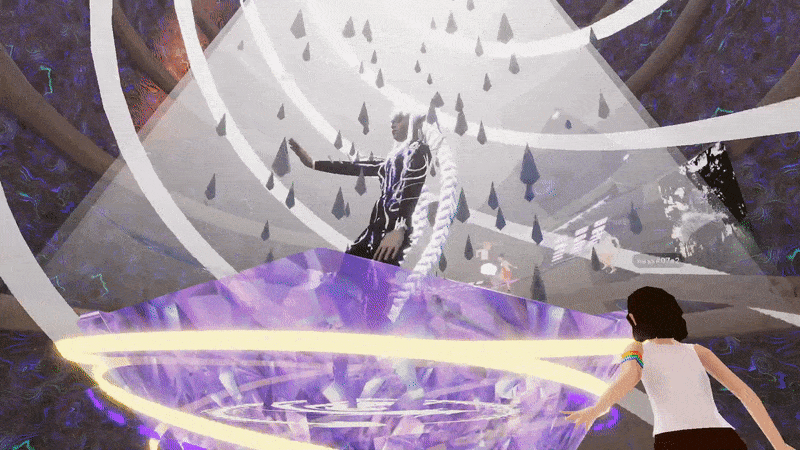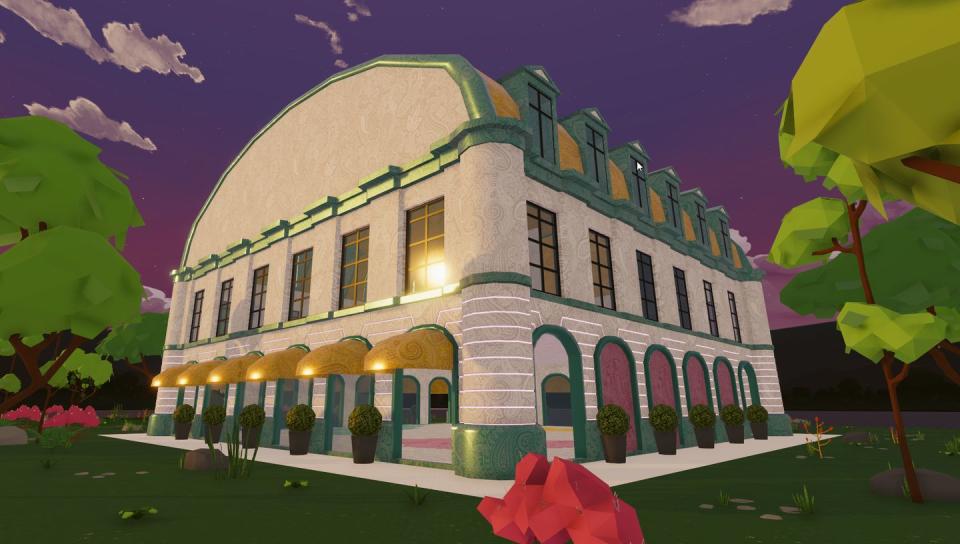The Highs and Lows of the First-Ever Metaverse Fashion Week

Several days ago, I put my Parcel glasses on and teleported into a party where Grimes was the headlining DJ. The far-from-ordinary fête was thrown by the digital fashion house Auroboros, who was celebrating the triumphant end of the first-ever Metaverse Fashion Week. And it was a banger.
Designed fully in 3D, the multi-level space was rife with avatars quietly peacocking their attention-grabbing looks. Grimes’s floor-length white hair was pulled back into a duo of braids; she was outfitted in Auroboros’s futuristic “Mystique” bodysuit, a digital wearable that was made available for purchase in limited quantities. My avatar, dressed in a simple black jumpsuit, paled in comparison, but still danced along to the riveting set with a series of pre-choreographed movements I had selected for her, so she could exist freely in the chaotic, unhinged moment.

Some context: Two years ago, at the height of the COVID-19 lockdown, the fashion industry was grappling with how best to present collections and keep brand narratives strong in the digital sphere. Since then, many high-tier labels (not to mention a handful of celebrity ambassadors) have been embracing NFTs and crypto, utilizing the virtual landscape to stay culturally relevant, curate experiences, and extend influence to reach a whole new digitally-savvy online audience.
“The pandemic has reinforced the importance of digital technology and the need for agility,” says Keith Wong, co-founder and chief operating officer of Singaporean fashion house Charles & Keith. “With the rising popularity of the metaverse and our belief in the need to continuously break new frontiers, it’s a great opportunity to express creativity and identity in new ways.”
Balenciaga’s collaboration with Fortnight and the virtual Gucci Garden experience on Roblox are two particularly successful examples of positioning luxury brands in the digital world, and other labels are following suit. The virtual-reality space has been taking the IRL world by storm—and the inaugural MVFW, hosted by the block chain-based platform Decentraland, curated a compelling mix of fashion, art, brand activations, panel talks, music, and commerce that emphasized its staying power.

“We felt that 2022 was an especially big year for digital fashion, observing other projects and brands like The Fabricant and Placebo getting involved in digital and physical fashion,” says Giovanna Graziosi Casimiro, Decentraland’s events and community producer. “We felt our community was ready to embrace that, and our creators were ready to work with brands.”
We saw IRL labels such as Dundas, Dolce & Gabbana, Etro, Imitation of Christ, Tommy Hilfiger, and Estée Lauder carve out space in the metaverse alongside tech giant Parcel, a virtual real estate marketplace, and digital fashion trailblazers like Auroboros. Over the course of the week, more than 60 brands presented 500 looks—some strictly for the metaverse—while others offered physical counterparts. The event was free and open to everyone, boasting over 30,000 visitors on the first day, over 6,000 of which headed straight to the luxury district. Here were the highlights (and lowlights).
Selfridges’s Digital Flagship
The week kicked off with the opening of Selfridges’s digital flagship in Decentraland, a recreation of its futuristic Birmingham store, complete with its iconic curved framework covered in aluminum discs. Launching a day before the official opening of MVFW, it set the bar high for what was to come.
Opening with an immersive exhibition that mirrored the real-life one at Selfridges in London, the virtual store displayed 12 limited-edition NFTs inspired by Paco Rabanne’s 1966 archives, done in collaboration with Op Art artist Victor Vasarely (to be sold later in April via a separate microsite). Two of the NFTs will be an edition of one, and will include a physical iteration of the garment that the atelier will create.
“Selfridges is known for pushing the boundaries and this is another exploration of that,” says Jeannie Lee, Selfridges’s head buyer for womenswear. “We launched this project to experience this area and to educate ourselves and our customers.” According to Lee, Selfridges will be using this endeavor to gauge peoples’ reactions before deciding on whether to pursue future activations.
The Luxury Shopping District
Inside the metaverse is a luxury shopping district modeled after Avenue Montaigne, where brands including Dolce & Gabbana, Etro, Elie Saab, Etro, Dundas, Jacob & Co., Franck Muller, Imitation of Christ, and Nicholas Kirkwood have virtual stores. But it looked less like the famed Paris shopping street and more closely resembled the Miami Design District, where all the stores are modern architectural gems, and the wares inside are displayed like museum artifacts. Dolce & Gabbana and Dundas used their respective spaces as retail storefronts for wearable designs, which were sold following their runway presentations, while Elie Saab used his virtual presence to present a selection of gowns and drive traffic back to his e-commerce site.
For his part, Kirkwood collaborated with artist White Rabbit on a pop-up shop that was hands down one of the funnest spaces in the district. Lighthearted and just the right amount of silly, it featured the shoe designer’s signature silhouettes reimagined for the metaverse in cartoonish proportions.
“You’re immersed in this video of iridescence and the shoes are floating with bubbles popping out of the floor—it’s a whole experience that I couldn’t do in real life,” Kirkwood says with a laugh.
The Kirkwood-White Rabbit collaboration unfolds in three different facets: You can wear the shoes on a gaming platform, collect artwork featuring White Rabbit wearing the corresponding shoes, or wear an AR version of the shoes coming out in a few weeks. The choice is yours, or you can feel free to choose them all. That’s the beauty of the metaverse.

Metaverse Merch
It turns out even in the metaverse, merch is highly coveted. And while several brands distributed digital wearables gratis, there were a few that stood out above the rest. For one, Parcel’s unique wearable glasses made experiencing MVFW infinitely more seamless. Navigating the metaverse was challenging, to say the least, but if you were able to snag these glasses at a kiosk, you could activate them and teleport into any district you wanted. It very much beat trying to plot the coordinates on the map (trust me).
For those hesitant to invest in digital wearables, Charles & Keith offered up freebies too. It gave away its popular Koa shoulder bag and Alex sandals to the first 1,000 visitors at its beautiful floral booth in Theedium. (I managed to cop a bag that gave me a sartorial edge from the generic outfit my avatar wore.) The momentum continued in the physical world, where the brand doled out 2o mini Koa bags via an Instagram contest.
Notably, Estée Lauder was the only beauty brand to participate in the metaverse. In doing so, it spotlighted one of its most popular products, the Advanced Night Repair Serum, by giving avatars a free virtual glow—a nod to the product’s hydrating qualities. Creative director Alex Box designed a so-called “radiance aura” that avatars could try out by standing under a supersized, digitized version of the signature brown bottle and activating a full-body glow. The experience was similar to wearing string lights at a music festival, in the best way possible.
Cash Labs’s Mixed-Media Art Gallery
Web3 agency Cash Labs curated a mixed-media gallery space that highlighted the intersection between fashion and art. Featuring over 20 artists including Krista Kim x The Fabricant and Karl Lagerfeld x The Dematerialized, who cross-pollinated the two disciplines with a series of NFTs, it marked a new era of collabs by adding in a futuristic digital component. As talk around NFTs reaches an industry-wide fever pitch, this space provided room to showcase the new vanguard of digital artists. SHOWStudio also participated in the Cash Labs Gallery, presenting fashion films from Nick Knight’s archives, along with footage from Alexander McQueen, Chanel, and Lanvin, among many others.
Dundas’s Runway Show
As you might imagine, digital fashion shows can be tricky, but Dundas delivered the perfect close to the week. Held in Decentraland’s fashion arena, avatars sauntered down the runway to a first-pumping soundtrack created specifically for the show. Scintillating wares (think: sexy silhouettes with daring cut-outs and ample lace detailing) served up high-octane glamour with digital extensions. “We’ve taken the approach of what we do in the physical world and tried to mirror that in the digital world as closely as we can,” says Dundas’s image director Evangelo Bousis.
For those who weren’t able to tune in, a preview of the 12 looks in Dundas’s collection were showcased at its pop-up store in the luxury shopping district prior to the presentation, and made available to purchase online. “We thought it would make it easier for people to understand the metaverse and how digital fashion will work,” adds Bousis. “Then, after the show, the next step is that you’ll be able to buy the digital versions: the digital and the physical objects together.”
Final Reflections
I’ll be honest: Metaverse Fashion Week was a lot to take in. And it wasn’t a perfect first outing either: technical glitches were felt all around. Computers crashed, loading pages took forever, and it was far from intuitive—moving around a complex space took a lot of getting used to (a search bar would have been helpful, as opposed to teleporting into the general vicinity and trying relentlessly to get your avatar to find the event in question). While there were plenty of fashion shows, very few were successful because the overall experience fell flat. Perhaps expectedly, many weren’t able to capture the magic of a physical show, where attendees are fully immersed and emotionally invested in the brand’s collection. The game-ified aesthetic in Decentraland took away from the fantasy and craftsmanship of luxury fashion and, simply put, the avatar models weren’t as inspiring.
However, MVFW did provide a glimpse into possibilities for how brands can build their narratives in the metaverse—offering immersive experiences and innovative ways to expand offerings beyond the physical. In a time where fashion should look toward the future rather than the past, that definitely counts for something.
You Might Also Like

 Yahoo Movies
Yahoo Movies 
